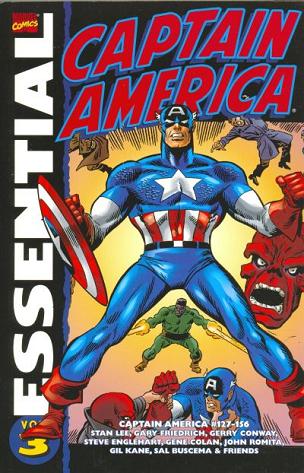
Essential Captain America Vol. 03
Stan Lee, Gary Friedrich, Steve Englehart, Gene Colan and friends
Reprints: Captain America #127-156 (July 1970 – December 1972)
Get this for: Captain America goes relevant — four stars
The previous volumes of Essential Captain America were heavy on the action, with Cap fighting enemies like the Red Skull and his Sleepers, Hydra, Baron Zemo, A.I.M. and Modok, often working together with Nick Fury and SHIELD. These were all fairly uncomplicated stories, but while the action continues in this volume, something does change as Captain America goes relevant. Stan Lee had dropped hints before that Cap was unhappy with his life and in #128 he went to find himself by touring America — somewhat of a cliche yes, but not so much when Cap did it.
And even on the road he’s not free of his old enemies, as he’s attacked by Batroc’s Brigade and runs into the Red Skull yet again. Nothing much changed there then, but like in Spider-Man at the same time, Lee does notice and comments on the changing attitudes of seventies America, having Cap interfere in a campus dispute and such, though as usual it turns out some supervillain was behind it. The same was of course the case with the return of Bucky Barnes. While Captain America has once again met with the disappointment of not having Bucky back, his next partner does stick around.
In issue 133 the Falcon, introduced in the previous volume, returns. The very next issue the series changed name to Captain America and the Falcon, showing how important this partnership was. The stories change again, becoming more gritty and streetlevel, centered on New York and Harlem though of course the supervillains are never far behind. Much of the background tension in the series at this point is provided by the race issue, as the Falcon has to find his place as what the world sees as a Black sidekick to a white man. It’s all very heavyhanded of course, both under Lee and his successor Gary Friedrich. So for example in #143 there’s the People’s Militia wanting to burn Harlem to the ground to “send a message to the honkies” that the Black man won’t be confined to the ghetto anymore, who turn out to have been manipulated by the Red Skull.
Old winghead goes through a lot of writers this volume btw. Starting with Lee for fifteen issues, then Gary Friedrich takes over for seven, then Gerry Conway gets to do four and ending with Steve Englehart for another four. Conway’s short run is the worst, with a complete mischaracterisation of Cap’s and Nick Fury’s relationship. Englehart starts strong, bringing back the fifties Captain America and Bucky as paranoid rightwing bigots. Friedrich was his usual self, a slightly hipper, with-it Stan Lee.
Artwise, this volume starts off well, with Gene Colan being a good match for Cap’s adventures. He’s succeeded by John Romita, who is slightly too clean cut for my liking here. Sal Buscema is the last artist to grace this volume, he’s doing alright but not great. It’s always been that way with Captain America, never a title to be considered for its art, save for some brief shining moments.
Somewhat of a mixed volume here then, not unmissable but for the hardcore fan. Like me.
